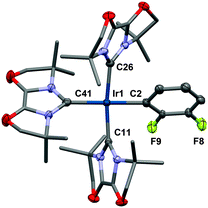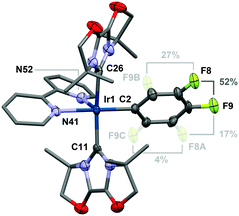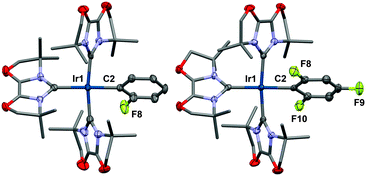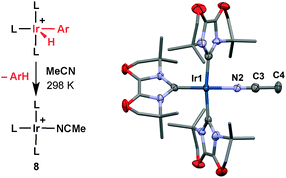 Open Access Article
Open Access ArticleCreative Commons Attribution 3.0 Unported Licence
Low-coordinate iridium NHC complexes derived from selective and reversible C–H bond activation of fluoroarenes†
Simone A.
Hauser
,
Ivan
Prokes
and
Adrian B.
Chaplin
*
Department of Chemistry, University of Warwick, Gibbet Hill Road, Coventry CV4 7AL, UK. E-mail: a.b.chaplin@warwick.ac.uk; Web: http://go.warwick.ac.uk/abchaplin Web: http://www.twitter.com/chapinlab
First published on 13th February 2015
Abstract
Interaction of the reactive 14 VE {Ir(IBioxMe4)3}+ fragment with fluoroarenes results exclusively in ortho-C–H bond oxidative addition and formation of 16 VE Ir(III) derivatives [Ir(IBioxMe4)3(Ar)H]+ (Ar = 2-C6H4F, 2,3-C6H3F2, 2,4,6-C6H2F3). The C–H bond activation reactions occur under mild conditions and are reversible.
The transition-metal-mediated C–H bond activation of partially fluorinated arenes is a potentially powerful means for accessing aryl fluoride synthons in organic chemistry,1,2 providing an orthogonal synthetic strategy to aryl C–F bond functionalisation and late stage aromatic fluorination protocols.3,4 Supporting the development of this methodology, an increasing number of transition metal systems capable of C–H bond activation of simple aryl fluorides are being described.5,6 Systems involving well defined and electronically unsaturated metal–aryl products are of particular interest as catalyst models, although examples remain scarce.7 As a latent source of a highly reactive 14 VE Ir(I) fragment, [Ir(PNP)(COE)]+ (COE = cyclooctene; PNP = 2,6-(PtBu2CH2)2–C5H3N) is particularly notable in this regard, undergoing C–H bond oxidative addition of fluorobenzene following dissociation of COE (Scheme 1).8 The reaction however lacks regioselectivity; selectivity that can be induced in analogous reactions with chloro- and bromo-benzene, through chelation of the halide to the metal. Similar chemistry is observed for the related neutral iridium fragment {Ir(PNP*)} (PNP* = (2-PiPr2-4-MeC6H3)2N−), although thermolysis ultimately results in C–X bond activation with PhCl and PhBr.9
As part of our ongoing work investigating the coordination chemistry of Glorius' bioxazoline derived NHC ligand IBioxMe4,10 we describe here an iridium system which is capable of selectively activating the C–H bonds of fluoroarenes under mild conditions and leads to electronically unsaturated 16 VE aryl hydride products. Drawing upon the conformationally rigid geometry to attenuate ligand cyclometalation, IBioxMe4 has previously enabled the isolation of [Rh(IBioxMe4)3][BArF4] (A, Scheme 2; ArF = 3,5-C6H3(CF3)2).11 Formally 14 VE, A is notable for the absence of any significant stabilising agostic interactions and complete solution stability (CH2Cl2, 1,2-C6H4F2). Targeting preparation of the iridium analogue 1, we reacted [Ir(COE)2Cl]2 with IBioxMe4 in 1,2-C6H4F2 in the presence of Na[BArF4] as a halide abstractor (293 K). Resulting instead in activation of the solvent, Ir(III) derivative [Ir(IBioxMe4)3(2,3-C6H3F2)H][BArF4] (2) was exclusively observed and subsequently isolated in high yield as an ∼1![[thin space (1/6-em)]](https://www.rsc.org/images/entities/char_2009.gif) :
:![[thin space (1/6-em)]](https://www.rsc.org/images/entities/char_2009.gif) 1 mixture of rotamers (76%). The selective formation of an ortho-activated derivative is in line with previous work that has established a strong electronic preference for C–H bond activation adjacent to fluorine substituents.1
1 mixture of rotamers (76%). The selective formation of an ortho-activated derivative is in line with previous work that has established a strong electronic preference for C–H bond activation adjacent to fluorine substituents.1
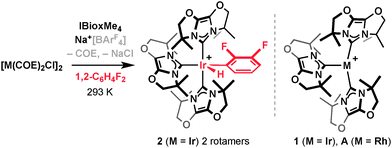 | ||
| Scheme 2 Preparation of tris-IBioxMe4 complexes of iridium and rhodium. [BArF4]− anions omitted for clarity. | ||
The formation of 2 is characterised by the presence of two sharp and very low frequency 1H resonances at δ −47.09 and −48.67, for each of the rotamers respectively, typical of species bearing hydride ligands trans to a vacant coordination site.12 The former hydride resonance shows a through space 1hJFH coupling of 3.7 Hz, identifying it as rotamer of 2 with the hydride and aryl fluoride groups syn with respect to the metal–aryl bond (as depicted in Scheme 2). Two sets of multiple coupled resonances at δ −111.6/−139.4 (3JFF = 27 Hz) and −114.9/−139.9 (3JFF = 28 Hz) are likewise observed in the 19F{1H} NMR spectrum (CD2Cl2). The former pair are ascribed to the syn-rotamer as the resonance at δ −111.6 shows 1hJFH coupling. The characterisation of 2 in solution is complemented in the solid-state by X-ray diffraction: one of the two independent, but structurally similar, cations of 2 is shown in Fig. 1. The rotamers cannot be distinguished due to disorder of the aryl ligands about the metal–aryl bond and the inability to locate the hydride ligands on the difference Fourier map. The 2-fluorine substituents notably remain significantly distant from the metal centre in 2 (Ir⋯F > 3.2 Å) and two methyl substituents of the IBioxMe4 ligands adopt strong CH⋯π interactions with the aryl ligand (ca. 2.3–2.7 Å); an interaction that is manifested in the 1H NMR spectrum by distinctly shielded methyl resonances (δ 0.15–0.28).
To help elucidate the underlying mechanism, we have investigated the reaction step-wise in 1,2-C6H4F2 (Scheme 3). Starting with [Ir(COE)2Cl]2, addition of excess IBioxMe4 resulted in rapid (<10 min) and quantitative formation of trans-[Ir(IBioxMe4)2(COE)Cl] (3), which retains the coordinated hydrocarbon ligand even on heating in the presence of IBioxMe4 (3 h, 333 K). Analogous iridium complexes containing less sterically imposing NHC ligands than IBioxMe4 (%Vbur = 32%) have previously been prepared under similar conditions.13 Interaction of [Ir(COE)2Cl]2 with more comparably sized ligands, however, is known to result in cyclometalation of the NHC, e.g. IMes (1,3-bis-mesitylimidazol-2-ylidene; %Vbur = 32%), IPr (1,3-bis(2,6-diisopropylphenyl)imidazol-2-ylidene; %Vbur = 34%) and ItBu (1,3-bis-tert-butylimidazol-2-ylidene; %Vbur = 36%).14,15 The formation and stability of 3, therefore reinforces the ability to partner IBioxMe4 with reactive metal centres without intramolecular activation.11 Reaction of isolated 3 with 1.1 equivalents of Na[BArF4] at 250 K resulted in the rapid liberation of COE (<10 min) and formation of an unstable hydride species 4 as the major organometallic species (ca. 80%). The formation of 4 is characterised by the presence of four low frequency hydride signals at δ −44.91, −46.37, −46.48 and −46.61 of similar intensity alongside multiple sets of coupled signals in the 19F NMR spectrum, suggesting unselective C–H bond oxidative addition of 1,2-C6H4F2. The formulation of 4 as 14 VE Ir(III) aryl hydride has structural precedence in the electronically similar dihydride [Ir(ItBu)2(H)2]+.15d
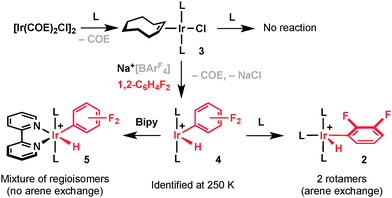 | ||
| Scheme 3 Mechanistic investigations into the formation of 2 (L = IBioxMe4). Reactions in 1,2-C6H4F2 at 293 K unless otherwise indicated. [BArF4]− anions omitted for clarity. | ||
As complex 4 proved intractable to further isolation, we instead sought to gain additional insight by studying its reactivity in situ with bipyridine and IBioxMe4. Consistent with 4 being a kinetically viable intermediate in the formation of 2 from [Ir(COE)2Cl]2, reaction with IBioxMe4 resulted in quantitative formation of 2 – containing solely an ortho-C–H bond activated difluorobenzene. Indeed 2 is conveniently prepared directly from 3, IBioxMe4 and Na[BArF4] in 1,2-C6H4F2 with an isolated yield of 74%. Reacting 4 instead with 2,2′-bipyridine led to complete conversion into 18 VE Ir(III) complex 5, which was ultimately isolated in 82% yield. This new complex is stable in CD2Cl2 and obtained as a ∼1.2![[thin space (1/6-em)]](https://www.rsc.org/images/entities/char_2009.gif) :
:![[thin space (1/6-em)]](https://www.rsc.org/images/entities/char_2009.gif) 1 mixture of ortho- and meta- difluorobenzene activation products, which in contrast to 2 shows restricted rotation about the metal–aryl bond on the NMR time scale (500 MHz). The dynamic processes are frozen out on cooling in CD2Cl2, however decoalescence for the 2,3-regioisomer occurs at significantly higher temperature (273 K, ΔG‡ ∼ 57 kJ mol−1) compared to the 3,4-regioisomer (200 K, ΔG‡ ∼ 46 kJ mol−1). The presence of isomers is also apparent in the solid-state structure, which crystallises as a mixture of regioisomers and their respective rotamers (Fig. 2).16
1 mixture of ortho- and meta- difluorobenzene activation products, which in contrast to 2 shows restricted rotation about the metal–aryl bond on the NMR time scale (500 MHz). The dynamic processes are frozen out on cooling in CD2Cl2, however decoalescence for the 2,3-regioisomer occurs at significantly higher temperature (273 K, ΔG‡ ∼ 57 kJ mol−1) compared to the 3,4-regioisomer (200 K, ΔG‡ ∼ 46 kJ mol−1). The presence of isomers is also apparent in the solid-state structure, which crystallises as a mixture of regioisomers and their respective rotamers (Fig. 2).16
The reactions of 4 suggest that the high regioselectivity observed in the formation of 2 is thermodynamic in origin, invoking reversible C–H bond activation and the transient presence of 1. This hypothesis is supported by the previous isolation of A and equilibrium reactions of 2 with fluorobenzene and 1,3,5-trifluorobenzene that result in the reversible formation of 6 (exclusively 2-regioisomer) and 7, respectively (monitored by 1H and 19F NMR spectroscopy, Scheme 4). The formulation of these new Ir(III) complexes was verified by independent synthesis from 3, IBioxMe4 and Na[BArF4] in the appropriate fluoroarene, with isolated yields of 66% and 80% for 6 and 7, respectively. Both complexes were fully characterised in solution and the solid-state and share similar structural characteristics with 2 (see ESI† and Fig. 3). Notably no arene exchange is observed for 5, suggesting the interaction of 4 with 2,2′-bipyridine has captured a mixture of kinetic products of fluoroarene activation on halide extraction from 3. Consistent with previous findings that M–C bond strength increases with F substitution,1 the equilibrium reactions clearly indicate more favourable oxidative addition in the order C6H5F < 1,2-C6H4F2 ≪ 1,3,5-C6H3F3.
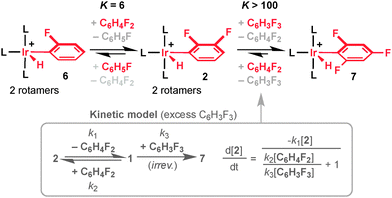 | ||
| Scheme 4 Arene exchange reactions (L = IBioxMe4). Measured at 298 K. [BArF4]− anions omitted for clarity. | ||
To help substantiate the transient presence of 1 in the C–H bond activation processes, we have probed the kinetics for the formation of 7 from 2 and 1,3,5-trifluorobenzene. Measuring the rate of this reaction using five different solvent mixtures of [1,2-C6H4F2] and [1,3,5-C6H3F3] (≥50 equiv./2) enabled us to establish a two-step kinetic model for the arene exchange, involving pre-equilibrium formation of 1 by reductive elimination of 1,2-difluorobenzene (R2 = 0.998 for fit, Scheme 4). Under this kinetic model, the rate of reductive elimination (k1) was determined to be (1.5 ± 0.9) × 10−3 s−1 at 298 K. For comparison, we have also estimated the rate of reductive elimination of 1,3,5-trifluorobenzene at 298 K ((1.96 ± 0.15) × 10−6 s−1) by dissolving 7 in pure 1,2-difluorobenzene, and measuring the initial rate of the ensuring reaction. Arene exchange is much faster for 6 in 1,2-difluorobenzene at 298 K (<10 min), corresponding to a lower bound for the rate of fluorobenzene reductive elimination at 298 K of 3 × 10−3 s−1.
In view of the facile elimination of fluorobenzene apparent from the aforementioned arene exchange reactions, we have also attempted to isolate 1 by dissolving 6 in perfluorotoluene at 293 K, but with limited success. Analysis by 1H NMR spectroscopy indicated the liberation of fluorobenzene into solution and the transient presence of a cationic tris-ligated IBioxMe4 species of high symmetry. The poor solubility and extremely high apparent reactivity of this species, however, has so far proven prohibitive to isolation and any further interrogation. Instead, we proceeded to trap out 1 using a strongly coordinating solvent. Dissolving 2, 6 and 7 in MeCN, resulted in reductive elimination of fluoroarene and formation of the acetonitrile adduct of 1, [Ir(IBioxMe4)3(NCMe)][BArF4] (8), in each case (Fig. 4). The rates for this reaction measured in situ by 19F NMR spectroscopy parallel those determined for the arene exchange reactions, although they are all slower presumably as a consequence of non-negligible coordination of MeCN to the aryl hydride precursors ((2.7 ± 0.3) × 10−3 s−1, 6; (0.120 ± 0.007) × 10−3 s−1, 2; (3.84 ± 0.13) × 10−7 s−1, 7; all at 298 K).17 In the case of 2, complex 8 was isolated in 87% yield (Fig. 4). In MeCN solution the reductive elimination of fluoroarene is to all intents and purposes irreversible. Successively dissolving 8 in 1,2-C6H4F2 and removing the solvent in vacuo, however, does eventually lead to the partial reformation of 2 (70% conversion after 7 cycles).
In summary, we have demonstrated that both bis-NHC and tris-NHC ligated Ir(I) species are capable of C–H bond oxidative addition of fluoroarene substrates under mild conditions, however it is only with the three coordinate {Ir(IBioxMe4)3}+ fragment that regioselectivity is achieved. The formation of ortho-activated products is in line with previous work purporting the electronic preference for activation at these positions and enabled through reaction reversibility.1 In view of related work using PNP and PNP* pincer scaffolds,8,9 it is evident that 14 VE Ir(I) fragments are well suited for C–H bond activation reactions of fluorinated aromatics, although their reactivity must be moderated in order to favour the formation of thermodynamic rather than kinetic activation products. Conformationally rigid IBioxMe4 ligands appear to be well suited to this purpose, combining resistance to intramolecular C–H bond activation with strong σ-donor and trans-influence characteristics. We are currently engaged in investigating ways in which such design principles can be applied in catalysis.
We gratefully acknowledge financial support from the Swiss National Science Foundation (S.A.H), Royal Society (A.B.C) and University of Warwick. Crystallographic data was collected using a diffractometer purchased through support from Advantage West Midlands and the European Regional Development Fund.
Notes and references
- E. Clot, O. Eisenstein, N. Jasim, S. A. Macgregor, J. E. McGrady and R. N. Perutz, Acc. Chem. Res., 2011, 44, 333–348 CrossRef CAS PubMed.
- (a) X. C. Cambeiro, T. C. Boorman, P. Lu and I. Larrosa, Angew. Chem., Int. Ed., 2012, 52, 1781–1784 CrossRef PubMed; (b) Y. Nakao, N. Kashihara, K. S. Kanyiva and T. Hiyama, J. Am. Chem. Soc., 2008, 130, 16170–16171 CrossRef CAS PubMed; (c) H.-Q. Do and O. Daugulis, J. Am. Chem. Soc., 2008, 130, 1128–1129 CrossRef CAS PubMed; (d) M. Lafrance, C. N. Rowley, T. K. Woo and K. Fagnou, J. Am. Chem. Soc., 2006, 128, 8754–8756 CrossRef CAS PubMed.
- (a) T. Ahrens, J. Kohlmann, M. Ahrens and T. Braun, Chem. Rev., 2015, 115, 931–972 CrossRef CAS PubMed; (b) M. K. Whittlesey and E. Peris, ACS Catal., 2014, 4, 3152–3159 CrossRef CAS; (c) M. F. Kuehnel, D. Lentz and T. Braun, Angew. Chem., Int. Ed., 2013, 52, 3328–3348 CrossRef PubMed.
- (a) T. Liang, C. N. Neumann and T. Ritter, Angew. Chem., Int. Ed., 2013, 52, 8214–8264 CrossRef CAS PubMed; (b) T. Furuya, A. S. Kamlet and T. Ritter, Nature, 2012, 473, 470–477 CrossRef PubMed; (c) D. A. Watson, M. Su, G. Teverovskiy, Y. Zhang, J. Garcia-Fortanet, T. Kinzel and S. L. Buchwald, Science, 2009, 325, 1661–1664 CrossRef CAS PubMed; (d) J. M. Brown and V. Gouverneur, Angew. Chem., Int. Ed., 2009, 48, 8610–8614 CrossRef CAS PubMed.
- (a) M. E. Evans, C. L. Burke, S. Yaibuathes, E. Clot, O. Eisenstein and W. D. Jones, J. Am. Chem. Soc., 2009, 131, 13464–13473 CrossRef CAS PubMed; (b) A. D. Selmeczy, W. D. Jones, M. G. Partridge and R. N. Perutz, Organometallics, 1994, 13, 522–532 CrossRef CAS.
- (a) A. S. Romanov and M. Bochmann, Organometallics, 2015 DOI:10.1021/om501211p; (b) J. C. DeMott, N. Bhuvanesh and O. V. Ozerov, Chem. Sci., 2013, 4, 642–649 RSC; (c) P. Lu, T. C. Boorman, A. M. Z. Slawin and I. Larrosa, J. Am. Chem. Soc., 2010, 132, 5580–5581 CrossRef CAS PubMed; (d) B. C. Bailey, J. C. Huffman and D. J. Mindiola, J. Am. Chem. Soc., 2007, 129, 5302–5303 CrossRef CAS PubMed; (e) E. Clot, M. Besora, F. Maseras, C. Mégret, O. Eisenstein, B. Oelckers and R. N. Perutz, Chem. Commun., 2003, 490–491 RSC; (f) J. J. Carbó, O. Eisenstein, C. L. Higgitt, A. H. Klahn, F. Maseras, B. Oelckers and R. N. Perutz, J. Chem. Soc., Dalton Trans., 2001, 1452–1461 RSC; (g) F. Godoy, C. L. Higgitt, A. H. Klahn, B. Oelckers, S. Parsons and R. N. Perutz, J. Chem. Soc., Dalton Trans., 1999, 2039–2048 RSC; (h) J. Forniés, M. Green, J. L. Spencer and F. G. A. Stone, J. Chem. Soc., Dalton Trans., 1977, 1006–1009 RSC.
- (a) K. B. Renkema, R. Bosque, W. E. Streib, F. Maseras, O. Eisenstein and K. G. Caulton, J. Am. Chem. Soc., 1999, 121, 10895–10907 CrossRef CAS; (b) R. Bosque, E. Clot, S. Fantacci, F. Maseras, O. Eisenstein, R. N. Perutz, K. B. Renkema and K. G. Caulton, J. Am. Chem. Soc., 1998, 120, 12634–12640 CrossRef CAS.
- (a) E. Ben-Ari, R. Cohen, M. Gandelman, L. J. W. Shimon, J. M. L. Martin and D. Milstein, Organometallics, 2006, 25, 3190–3210 CrossRef CAS; (b) E. Ben-Ari, M. Gandelman, H. Rozenberg, L. J. W. Shimon and D. Milstein, J. Am. Chem. Soc., 2003, 125, 4714–4715 CrossRef CAS PubMed.
- The regioselectivity of the C–H bond activation of PhF is not discussed in great detail, except that the number of isomers changes on thermolysis. L. Fan, S. Parkin and O. V. Ozerov, J. Am. Chem. Soc., 2005, 127, 16772–16773 CrossRef CAS PubMed.
- G. Altenhoff, R. Goddard, C. W. Lehmann and F. Glorius, J. Am. Chem. Soc., 2004, 126, 15195–15201 CrossRef CAS PubMed.
- (a) A. B. Chaplin, Organometallics, 2014, 33, 3069–3077 CrossRef CAS; (b) A. B. Chaplin, Organometallics, 2014, 33, 624–626 CrossRef CAS.
- P. S. Pregosin, NMR in Organometallic Chemistry, Wiley-VCH, Weinheim, 2012 Search PubMed.
- D. J. Nelson, B. J. Truscott, A. M. Z. Slawin and S. P. Nolan, Inorg. Chem., 2013, 52, 12674–12681 CrossRef CAS PubMed.
- A. Poater, B. Cosenza, A. Correa, S. Giudice, F. Ragone, V. Scarano and L. Cavallo, Eur. J. Inorg. Chem., 2009, 1759–1766 CrossRef CAS.
- (a) C. Y. Tang, W. Smith, A. L. Thompson, D. Vidovic and S. Aldridge, Angew. Chem., Int. Ed., 2010, 50, 1359–1362 CrossRef PubMed; (b) C. Y. Tang, W. Smith, D. Vidovic, A. L. Thompson, A. B. Chaplin and S. Aldridge, Organometallics, 2009, 28, 3059–3066 CrossRef CAS; (c) N. M. Scott, R. Dorta, E. D. Stevens, A. Correa, L. Cavallo and S. P. Nolan, J. Am. Chem. Soc., 2005, 127, 3516–3526 CrossRef CAS PubMed; (d) N. M. Scott, V. Pons, E. D. Stevens, D. M. Heinekey and S. P. Nolan, Angew. Chem., Int. Ed., 2005, 44, 2512–2515 CrossRef CAS PubMed.
- Refinement of the aryl substituents yields different isomer ratios to those observed in solution, presumably resulting from subtly different crystal packing effects and crystallisation kinetics of the isomers.
- Supporting the suggestion of reversible interaction of MeCN with the aryl hydride complexes, line broadening of the hydride resonance(s) is/are observed in d3-MeCN at 298 K.
Footnote |
| † Electronic supplementary information (ESI) available: Full experimental details and selected NMR spectra. CCDC 1037606 (2), 1037607 (5), 1037610 (6), 1037611 (7) and 1037618 (8). For ESI and crystallographic data in CIF or other electronic format see DOI: 10.1039/c5cc00529a |
| This journal is © The Royal Society of Chemistry 2015 |


